#around seattle or whatever was inspired by the walls around the west bank with the watch towers and everything it makes me so sick
Text
a thread by twitter user @tugunl about life in palestine i thought i would translate and share. it was posted in august, so "before october 7th". most of the pictures are screenshots of videos i couldn't include, i linked them at the start of each relevant paragraph. op was told that he shouldn't defend palestine and didn't know what he was talking about because he didn't live there. what he reported after spending over a month in palestine:
A few months ago, this person criticized me for defending Palestine without even having lived there. And it was true.
So I went to live there. After spending more than a month there, here is the reality of Palestinian daily life:
First, this individual claimed that "Israelis have no right to go to Arab territories". This is completely untrue. Here is an example of an Israeli colony, established in the Palestinian Territory. There are several others. You can see Israeli settlers walking peacefully in Palestinian Territories. There are now several hundred thousand living there.

Another example of a colony: In Hebron, Israelis live in the city center, right above Palestinians.
But of course, you wouldn't want them to mix and live together: they put barbed wire to separate them. Above, Israelis, below, Palestinians.
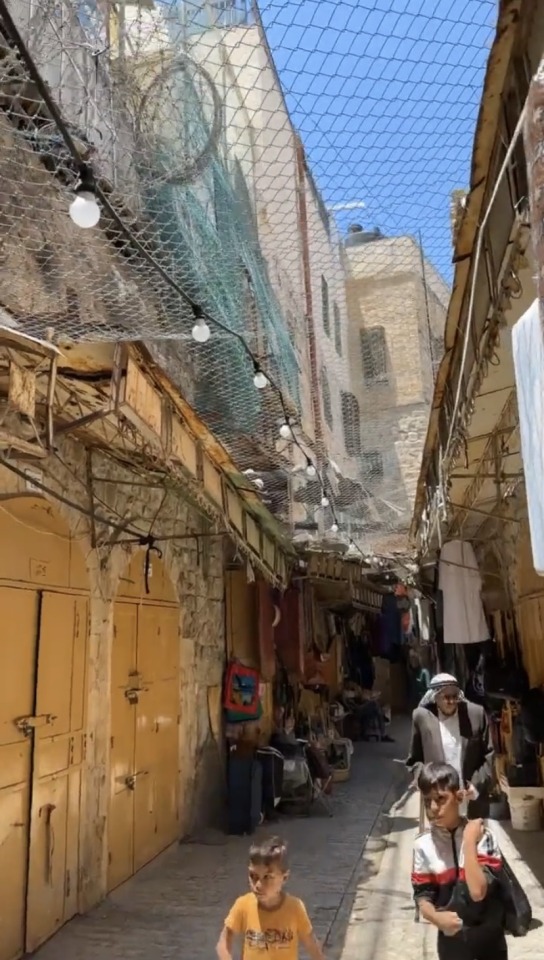
Pictured here are stones thrown by Israeli settlers at Palestinians.

What's most telling in Palestine: cemeteries. This one opened in 2021, it is already full. In just two years, the cemetery was filled, including with a lot of children.

The reality is Palestinians live in an open-air prison. They are surrounded by these walls, which lock them into territories reserved for them. More than 700 kilometers of walls. So no, Palestinians cannot "freely travel to Israel".
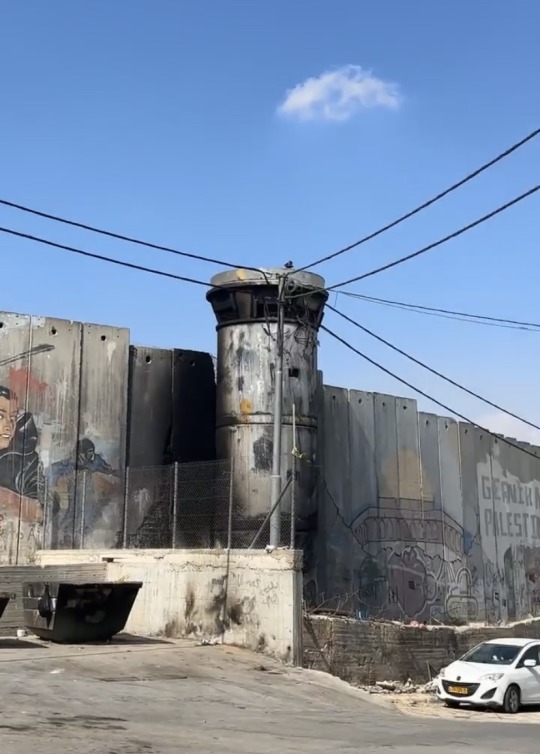
They cannot even go to Jerusalem, unless they have a permit, which is difficult to obtain. Because yes, if you go to Jerusalem as a Palestinian without authorization, you will be arrested at this kind of military checkpoint. God only knows what happens next.
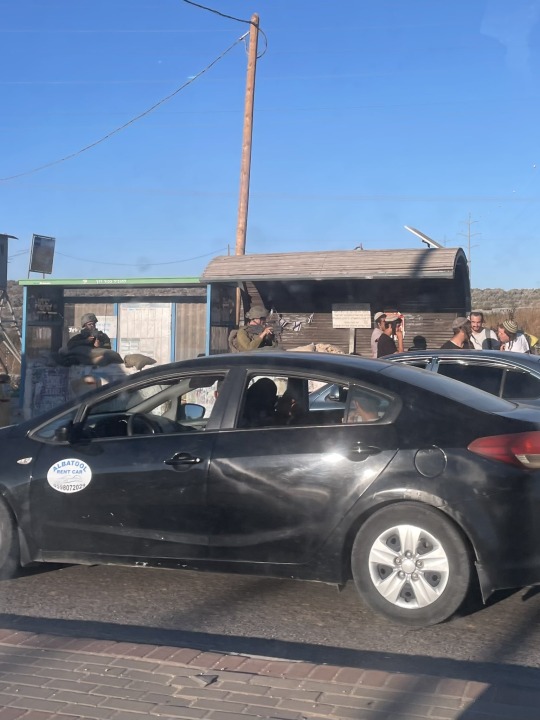
These military checkpoints allow Israelis to control traffic in the Occupied Palestinian Territories and the border between Israel and Palestine: All it takes is for one soldier to decide to close the barrier for everyone to be blocked.
Thus, any Israeli soldier is superior to any Palestinian authority. All it takes is for the soldier to lower the barrier to trap the president of the Palestinian Authority behind this barrier. There are over 650 checkpoints of this kind.
Another thing you should know: Israel operates under a system of collective punishment. An attack committed against Tel Aviv? All roads in Palestine will be blocked to punish the population.
Palestinians obviously don't have the right to use roads reserved for Israelis. How can the military tell them apart? Thanks to their license plate. Israelis have a yellow plate, Palestinians have a white plate. An example of the disastrous consequences of the ban on Palestinian circulation: At a school, a young girl required medical attention. The ambulance had to wait 5 hours, the time needed to obtain Israeli authorization to travel on their roads.
Because of these restrictions, a journey that would take 15 minutes to complete if you were Israeli takes an hour if you are Palestinian.

Colonies under construction. Guess who builds them? Palestinians. Of course, because it costs a lot less to employ Palestinians.
I infiltrated a colony. Settlers live very well there. Real estate is cheap since land is free (stolen by the state). It's very green, water is used for the grass and the plants there.
In Palestinian territories, I didn't have water 4 days out of 7.
Because yes, Israel monopolizes 83% of water resources and leaves only 17% to Palestinians, which of course is far from being enough.

On the left, Tel Be'er Sheba, ghetto for Palestinians. Less than 1km from Omer. One of the poorest villages.
On the right, Omer, 3rd best village to live in in Israel, also one of the richest villages (reserved for Israelis obviously).

By the way, this is where the waste of Israeli settlers in the North ends up: in this river, which flows to the Palestinians in the South.
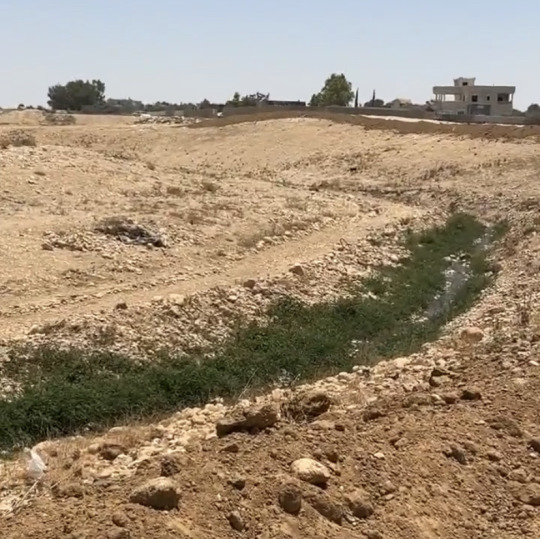
This is an example of Palestinian (in this case, Bedouin) habitat destroyed by settlers. These destructions number in the thousands. Palestinians are losing their homes, which are then replaced by Israeli settlements.
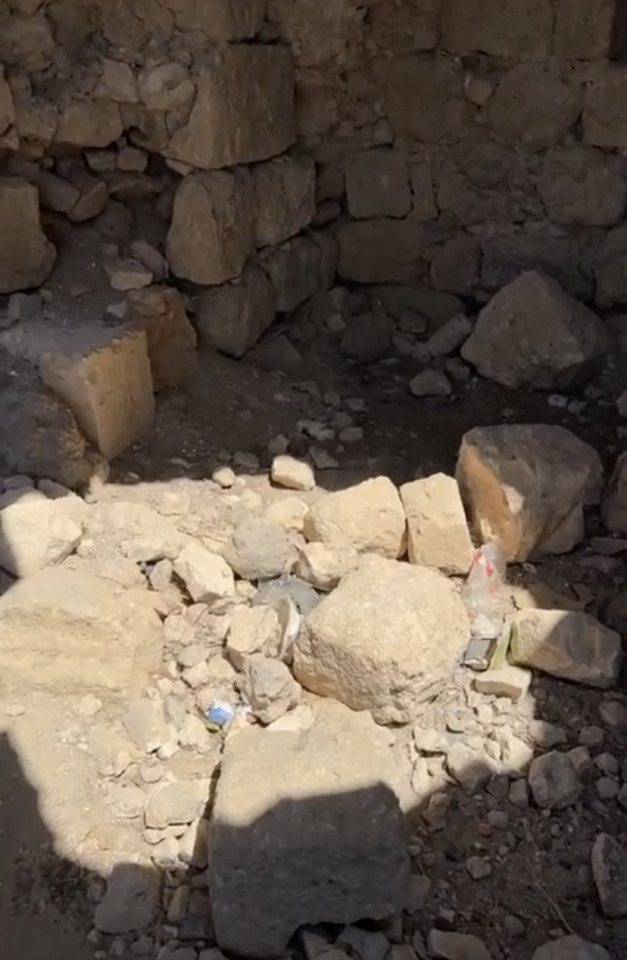

Israel implements a legal regime that makes settlers superior to Palestinians.
So a Palestinian is considered an adult at 14 years old while an Israeli settler is considered an adult at 18. A 14-year-old Palestinian who commits a crime will face the punishment of an adult.
Here, near Al-Khalil (Hebron), 7-year-old Ryan Sliman died of a heart attack after being frightened by Israeli settlers who chased him.
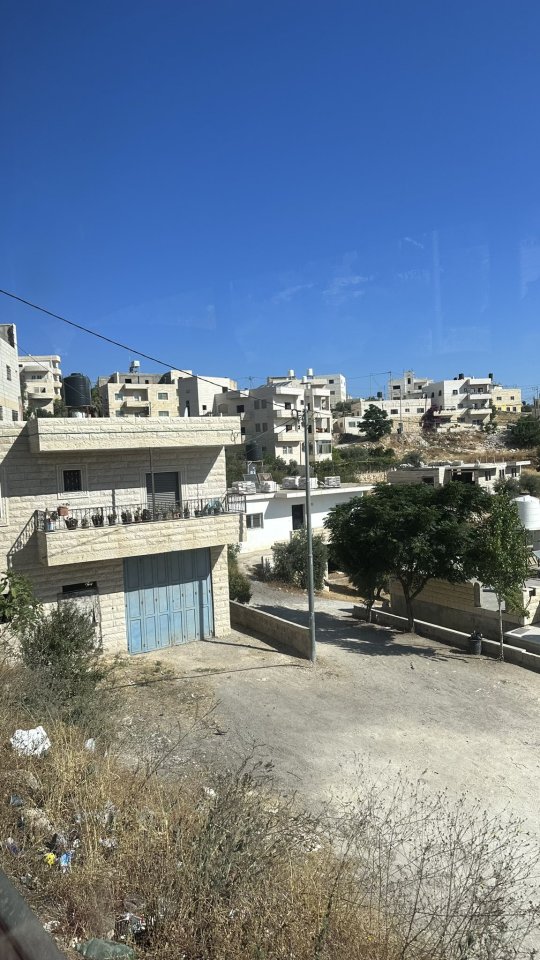
Palestinians are losing their lives in this fight for freedom and dignity. This Palestinian marked his flag with his blood before giving it his life.
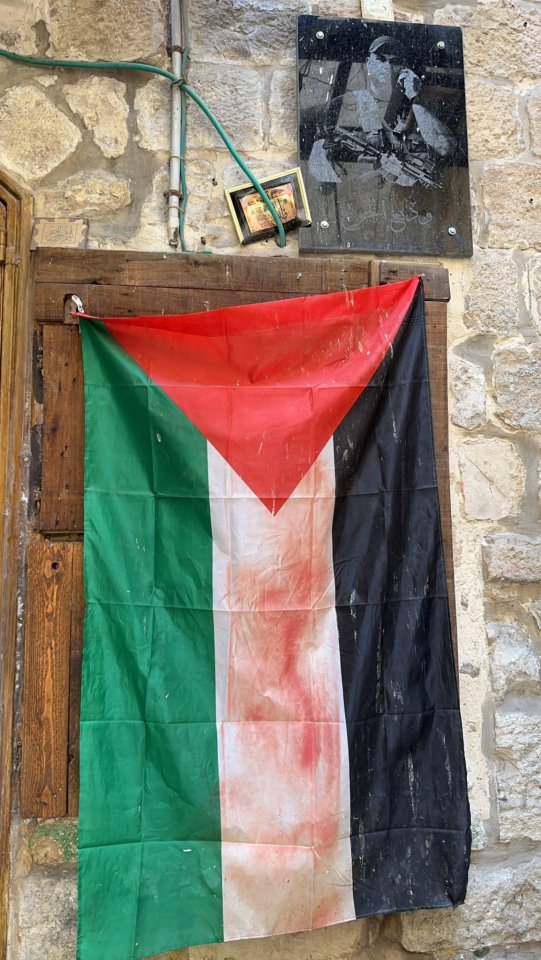
Bonus: if you're foreign and transiting through Israel, be aware that this country uses racial profiling to determine wether or not you're a threat to them. If you have a foreign-sounding first name, especially from Middle-Eastern and North African countries, or if you have a beard that makes you look too Muslim for them, you will undergo very thorough checks at the airport and a very long interrogation with sometimes personal questions, as well as a search of your electronic devices and of your luggage. I personally underwent an hour-long interrogation, with numerous questions, including:
Are you Muslim?
Why do you have a beard?
Where do you come from? What are your parents' first names?
Why do you have a visa from Tunisia and the United Arab Emirates?
...
Also note that the cost of living in Palestine is quite expensive, due in part to taxation. The products are doubly taxed: first by the settler state, Israel, but also by the Palestinian Authority.
You should also know that I have met Israelis who are formally anti-Zionist but who only have Israeli nationality and therefore cannot move to another country even though they wish to emigrate. I am not at all saying that this is the opinion of the majority of Israeli people, but I mean that not everyone is Zionist. Hence the importance of distinguishing them.
Last tweet added to the thread on October 18th:
Note: Currently, new large-scale clashes are occurring in the Gaza Strip, causing the deaths of many Palestinian civilians.
This thread was written two months ago, well before these events. If the media today try to manipulate information, particularly in favor of an Israeli state that supposedly has “the right to defend itself”, what you see in the tweets above is the reality on the ground.
Palestinians experience this all year round, from birth to death. The current context only reinforces all the horrors they are experiencing.
#comme ça qu'on les réveille#free palestine#palestine#west bank#this took me a while and not for the reasons you would expect#idk if you guys have seen that article about the last of us and especially part 2 having pro-israel politics but they said the fence/wall#around seattle or whatever was inspired by the walls around the west bank with the watch towers and everything it makes me so sick#i don't play and i haven't watched the show but#the article actually doesn't say pro-israel it just says israeli politics. but anyway#and like i say: brf slt
72 notes
·
View notes
Text
The Not So Hidden Israeli Politics of ‘The Last of Us Part II’
The real horror in zombie fiction is usually not the legions of undead, but the frailties and cruelties that they expose in the living. The differences between stories in the genre come from the specific fears and frustrations that they render into their metaphors. The Last of Us Part II fits perfectly within these genre conventions, but what’s different here is its sources of inspiration.
The Last of Us Part II focuses on what has been broadly defined by some of its creators as a “cycle of violence.” While some zombie fiction shows human depravity in response to fear or scarcity in the immediate aftermath of an outbreak, The Last of Us Part II takes place in a more stabilized post apocalypse, decades after societal collapse, where individuals and communities choose to hurt each other as opposed to taking heinous actions out of desperation.
More specifically, the cycle of violence in The Last of Us Part II appears to be largely modeled after the Israeli-Palestinian conflict. I suspect that some players, if they consciously clock the parallels at all, will think The Last of Us Part II is taking a balanced and fair perspective on that conflict, humanizing and exposing flaws in both sides of its in-game analogues. But as someone who grew up in Israel, I recognized a familiar, firmly Israeli way of seeing and explaining the conflict which tries to appear evenhanded and even enlightened, but in practice marginalizes Palestinian experience in a manner that perpetuates a horrific status quo.
The game’s co-director and co-writer Neil Druckmann, an Israeli who was born and raised in the West Bank before his family moved to the U.S., told the Washington Post that the game’s themes of revenge can be traced back to the 2000 killing of two Israeli soldiers by a mob in Ramallah. Some of the gruesome details of the incident were captured on video, which Druckmann viewed. In his interview, he recounted the anger and desire for vengeance he felt when he saw the video—and how he later reconsidered and regretted those impulses, saying they made him feel “gross and guilty.” But it gave him the kernel of a story.
“I landed on this emotional idea of, can we, over the course of the game, make you feel this intense hate that is universal in the same way that unconditional love is universal?” Druckmann told the Post. “This hate that people feel has the same kind of universality. You hate someone so much that you want them to suffer in the way they’ve made someone you love suffer.”
Druckmann drew parallels between The Last of Us and the Israeli-Palestinian conflict again on the official The Last of Us podcast. When discussing the first time Joel kills another man to protect his daughter and the extraordinary measures people will take to protect the ones they love, Druckmann said he follows “a lot of Israeli politics,” and compared the incident to Israel’s release of hundreds of Palestinians prisoners in exchange for the captured Israeli soldier Gilad Shalit in 2011. He said that his father thought that the exchange was overall bad for Israel, but that his father would release every prisoner in every prison to free his own son.
“That’s what this story is about, do the ends justify the means, and it’s so much about perspective. If it was to save a strange kid maybe Joel would have made a very different decision, but when it was his tribe, his daughter, there was no question about what he was going to do,” Druckmann said.
Naughty Dog and PlayStation have presented Druckmann as The Last of Us Part II‘s creative lead and public face. Game development is a highly collaborative practice that demands the backbreaking labor of literally hundreds of programmers, testers, writers, and artists, all of whom make creative contributions and without whom a game of this size and scope would not exist. So while it’s impossible to pin a big budget video game’s themes and inspirations to one person, parallels between The Last of Us Part II and the Israeli-Palestinian conflict manifest in the final product, not just in what Druckmann has said in interviews.
Besides the familiar zombie fiction aesthetics of an overgrown and decomposing metropolis, The Last of Us Part II‘s main setting of Seattle is visually and functionally defined by a series of checkpoints, security walls, and barriers. There are many ways to build and depict structures that separate and keep people out. Just Google “U.S.-Mexico border wall” to see the variety of structures on the southern border of the United States alone. The Last of Us Part II‘s Seattle doesn’t look like any of these. Instead, it looks almost exactly like the tall, precast concrete barriers and watch towers Israel started building through the West Bank in 2000.
The history and power dynamics of The Last of Us Part II‘s Seattle map to the Israeli-Palestinian conflict as well, if viewed from an Israeli perspective.
The main faction in Seattle is the Washington Liberation Front (WLF), known as the Wolves. The broad strokes are that after the outbreak, FEDRA, an emergency militaristic government agency, took over the city. With food shortages, constant fear of infection, and FEDRA’s increasingly brutal measures of keeping order, an insurgency rose: the Wolves. They were outmatched, but prevailed with a series of hit-and-run attacks, assassinations of FEDRA officers, and other guerilla tactics. Eventually, FEDRA abandoned the city and ceded control to the Wolves, who in turn implemented an equally harsh (or harsher) regime.
In one in-game note, a FEDRA commander in Seattle writes to Central Command to explain that he has lost the city the Wolves, which he describes as terrorists. Here, there are parallels to early Zionist organisations that fought British rule in the region. These organizations were also described as terrorists, and leaders of those organizations later became leaders in Israel, much like how Isaac, the leader of the Wolves, came to control Seattle. Other in-game notes, scenes of urban ambushes, and the bodies of executed FEDRA officers laboriously walk the player through the cliche “one man’s terrorist is another man’s freedom fighter.”
Once Isaac and the Wolves seized control of Seattle by violent means, however, the same means were used against them by another group—one that uncomfortably matches Israeli caricatures of Palestinians.
Most of the Wolves regime’s restrictions are directed at a post-apocalyptic religious sect called the Seraphites (the Wolves call them “Scars” after the ritualistic scarring of their faces). These Scars vexed FEDRA as well when it was in control. The dynamic in the city when the game begins is one of conflict, escalation, and a broken truce. The Wolves, like FEDRA, leverage more resources and raw power, while the Scars rely on surprise strikes against Wolf patrols, and a zealous willingness to die for the cause.
To run through just a few key ways in which the Scars uncomfortably reflect some Israeli stereotypes about Palestinians:
The same note from the Seattle FEDRA commander that bitterly says the Wolves are in charge explains that it’s now their responsibility to not only feed and shelter the people of Seattle, but deal with the “religious fanatics,” referring to the Scars.
Later in the game, Ellie finds a location called “Martyr Gate,” where the Scars’ spiritual leader apparently died, indicating a religious significance of a specific and disputed location, and emphasizing the notion of martyrdom as central to their culture.
The Scars are able to get around Wolf patrols and various barriers around the city via an elaborate, secret system of bridges between skyscrapers. These function as a kind of flipped version of the underground tunnels Palestinians use to bypass Israeli blockades and other means of limiting free movement in order to get supplies and carry out attacks on Israel.
The Last of Us Part II goes to great pains to impress that it sees no innocent players in this conflict. It’s not just that Isaac and the Wolves seized control of the city by vicious (but necessary) means—the society they’ve built, prosperous and protected by the walls of Seattle’s CenturyLink Field, is buttressed by fascisim and cruelty to an outgroup. The Wolves’ bountiful crops exist to feed an army that ventures far beyond its territory to punish the Scars. Its kennels of adorable dogs are just disposable weapons. Isaac leads from a forward operating base that sits atop torture chambers. After a truce fails, the only way he can imagine peace is through the total annihilation of his enemies.
It is not a peaceful or just society, or even a sustainable one in the long run, despite its perseverance and resourcefulness. It is one that is doomed to collapse because of an inability, or unwillingness, to resolve a perfectly resolvable conflict.
This conflict comes to a head when Isaac decides to push deep into the Scars’ land to finish them once and for all. We don’t get to see how the battle ends or who comes out on top, but we see Isaac die in the fighting, and get the sense that the battle is so brutal and bloody, whatever survives is not worth keeping.
Rather than step back, cooperate, and seek truth and reconciliation, the Wolves and Scars keep seeking revenge for past grievances in a cycle of violence that eventually ends them both in literal fires sparked by hate. The game’s message seems to be: “An eye for an eye leaves the whole world blind,” another cliche that The Last of Us Part II indulges in by taking away Tommy’s eye at the end of the game for seeking revenge for his brother Joel.
A “cycle of violence” is a tempting way to interpret this conflict, or any conflict, because it signals careful nuance while quietly squashing more difficult conversations. By suggesting that since both Wolves and Scars are equally implicated and equally in pain, we are free to stop thinking about the problem. All parties include both good and bad actors. We’re all human. Both sides.
This common, centrist position on violent conflict, while better than absolute dehumanization, is not coincidentally a world view that allows conflicts to drag on forever. Suggesting moral equivalence and a symmetry in ability between sides also invites us to throw up our hands and give up on better solutions because of implied and unexamined perceptions about “human nature.” Indeed, the game is unrelentingly cynical, and this cynicism animates most of the 30-odd hour experience. Whereas Abby and Ellie find interpersonal resolution at the end, the game seems content to leave the question of community-scale cycles of violence as a regrettable fact of human existence. Even if the Wolves and Scars meet their mutual end, the game leaves us with the knowledge that a resistance group from the first game, the Fireflies, and other groups, are regrouping and gaining strength. The cycle continues.
Despite the lengths it goes to, The Last of Us Part II can’t help but reveal that its perspective is firmly rooted in one side and not the other.
Seattle is so clearly inspired by Israel and Palestine without naming either, but it does notably spend time presenting Jewish identity. One of the first things Ellie and Dina do when they arrive in Seattle is explore a former synagogue. It’s a short scene, maybe 20 minutes out of a 30-plus hour game, and it serves as a kind of a Jewish experience amusement park ride, bombarding the player with references and history as Dina and Ellie walk around a bimah, find a Torah, and so on. Almost the entirety of this section is spent explaining Jewish identity as that of survivors in the face of other groups that want to destroy them. In the span of those 20 minutes, there are three separate references to the Holocaust.
Survival in the face of persecution is a pillar of Jewish identity for good reason, and has been since before the Holocaust. It’s also one that is relevant to the characters in the game, all of whom are survivors of a zombie apocalypse. But this is only one aspect of Jewish identity. The Last of Us Part II doesn’t spend any time exploring, for example, Talmudic traditions which define so much of Jewish notions of justice and scholarship. Instead, in a non-optional section of the game, it spends a significant amount of time telling the player that Jews are always persecuted and fighting for survival. This is not wrong, but it is serving a specific purpose in the ham-fisted allegory about Israel and Palestine that is The Last of Us Part II, much like the Holocaust is cynically leveraged by some to justify Israel’s actions.
This sermon is notably delivered by Dina, who is Jewish and serves as the game’s moral compass. Dina is pregnant, dreams of a life of peace, and tries to turn Ellie back from her murderous quest. When Ellie chooses to pursue it anyway, the heaviest price she pays is that Dina leaves her.
*
The more moral characters in The Last of Us Part II all want to escape cycles of violence rather than reckon with them. Lev and Yara want to escape their cult. Owen and Mel want to get on a boat and sail away from Seattle. Dina wants to walk away from the mess and live on a farm secluded from the rest of society. Even our main characters, Ellie and Abby, after far too much suffering, essentially end their emotional journey when they decide to walk away from revenge.
It’s certainly true that individual lives get wrapped up in larger conflicts in horrible ways. Cycles of violence exist in practice as escalations and retributions. A defining feature of the Israeli-Palestinian conflict is the macabre bargaining over which violence is worse. Images of exploded public buses are presented next to collapsed buildings and children being pulled from the rubble. Armed factions swear to deliver retaliation over specific incidents, and do.
But “cycles of violence” are a poor way to understand a conflict in a meaningful way, especially if one is interested in finding a solution. The United States, for example, hasn’t been at war in Afghanistan for almost 20 years because it’s trapped in a “cycle of violence” with the Taliban. It is deliberately choosing to engage with a problem in a way that perpetuates a conflict. Just as the fantasy of escaping violence by simply walking away from it is one that only those with the means to do so can entertain, the myth of the “cycle of violence” is one that benefits the side that can survive the status quo.
In The Last of Us Part II‘s Seattle, Scars and Wolves hurt each other terribly, and the same can be said about Israel and Palestine. The difference is that when flashes of violence abate and the smoke clears, one side continues to live freely and prosper, while the other goes back to a life of occupation and humiliation. One side continues to expand while the other continues to lose the land it needs to live. Imagining this process as some kind of symmetric cycle benefits one side more than the other, and allows it to continue.
As a result, The Last of Us Part II never quite justifies its fatalism. As Rob Zacny wrote in his review and again in his closer examination of The Last of Us Part II‘s ending, at the end of the day Ellie’s journey of revenge seems especially cruel, even idiotic, because we are never given a good reason for why she keeps recommitting to it. Acts of cruelty along the way, like Ellie’s torturing another character to get information, are presented as inevitable. This seems to be The Last of Us Part II‘s thesis: humans experience a kind of “intense hate that is universal,” as Druckmann told The Post, which keep us trapped in these cycles.
But is intense hate really a universal feeling? It’s certainly not one that I share. I, too, have seen the video of the 2000 mob killing of the Israeli soldiers in Ramallah, and it’s horrific. Yet, my immediate response wasn’t “Oh, man, if I could just push a button and kill all these people that committed this horrible act, I would make them feel the same pain that they inflicted on these people,” as Druckmann said.
This is not a universal feeling as much as it’s a learned way of seeing the world. There are many other ways to react to that video: compassion for the victims, compassion for the killers, questioning why these soldiers had to drive into the West Bank in the first place, questioning what would drive a mob to this kind of violence. Revenge and hate is just one option.
The Last of Us Part II is an incredible journey that provides not only one of the most mesmerizing spectacles that we’ve seen from big budget video games, but one that manages to ask difficult questions along the way. It’s clearly coming from an emotionally authentic and self-examining place. The trouble with it, and the reason that Ellie’s journey ultimately feels nonsensical, is that it begins from a place that accepts “intense hate that is universal” as a fact of life, rather than examining where and why this behavior is learned.
Critically, by not asking these questions, and by masking its point of view as being evenhanded, it perpetuates the very cycles of violence it’s supposedly so troubled by.
Credit: Source link
The post The Not So Hidden Israeli Politics of ‘The Last of Us Part II’ appeared first on GIZED - Breaking News Worldwide.
from WordPress https://ift.tt/3er8sm8
via IFTTT
0 notes